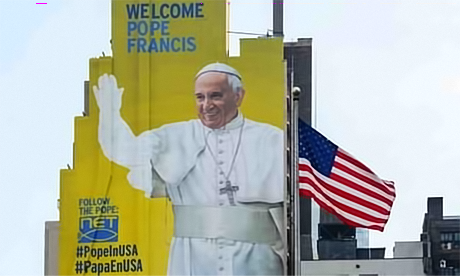The last time there was this much excitement about a pope’s inaugural visit to the United States, Pink Floyd’s “Another Brick in the Wall” topped the Billboard charts, Jimmy Carter was in the White House, and cell phones were the size of a brick.
But those aren’t the only differences between Pope John Paul II’s historic 1979 visit and Pope Francis’ virgin trip to the US this week.
Pope Francis will find a church that is markedly different in a number of significant ways; so different, in fact, that it calls into question whether we can still refer to the Catholic Church in the US.
When JPII made his first visit US, he found a church that was in transition but largely intact.
Some 40 percent of Catholics went to mass in any given week and there were nearly 60,000 Catholic priests and 135,000 nuns, with the nation’s 18,800 parishes boasting an average of two priests each.
The sacraments were still a major part of most Catholics’ lives: there were nearly 1 million baptisms and 350,000 Catholic marriages.
The controversy over Humanae Vitae ten years earlier had largely subsided; most Catholics used birth control and most priests ignored the issue.
The Catholic Church had tried valiantly over the previous decade to make abortion a major political issue for Catholics as it pressed the issue of a constitutional ban, but with little success.
Even the head of the church’s own National Committee for a Human Life Amendment admitted that the “overwhelming majority” of Catholics were apathetic about the issue.
Orthodox Catholics fretted about the rise of “cafeteria” Catholics who picked and chose from doctrine, particularly around issues related to sex, but most continued to identify as Catholics, raise their children as Catholics and take part in the life of the church.
Some formed reform groups like Call to Action and the Women’s Ordination Conference to agitate for a more democratic church and clerical roles for women.
A very different Church
Pope Francis will find a very different church.
According to the Center for Applied Research in the Apostolate
- Only one-quarter of Catholics attend mass every week (CARA has some of the best, most rigorous tracking of mass attendance; other surveys find higher percentages using more generous methodologies);
- the number of priests and nuns has declined precipitously; from 58,000 to 38,000 for priests and from 125,000 to 50,000 for nuns;
- despite a significantly larger population, there are 1,300 fewer parishes, with an average of just one priest per parish;
- some 3,500 parishes have no resident priest;
- the sacraments are no longer as central to the lives of Catholics;
- the number of baptisms has declined from nearly 1 million to just over 700,000, and the number of marriages within the church has declined by nearly half;
- only the number of Catholic funerals has held steady.
And while the number of Catholics overall has remained level, that’s largely due to Hispanic migration to the US; some 40 percent of those born Catholic have left the church.
But numbers don’t tell the whole story. The church Francis will encounter is fundamentally different in character from the church of John Paul in two important ways. Continue reading
Sources
- Religion Dispatches
- Image: Daily News
News category: Features.




